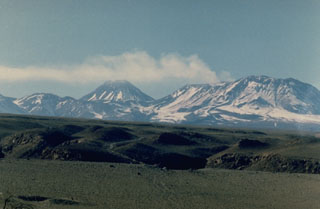Report on Lascar (Chile) — 25 January-31 January 2023
Smithsonian Institution / US Geological Survey
Weekly Volcanic Activity Report, 25 January-31 January 2023
Managing Editor: Sally Sennert.
Please cite this report as:
Global Volcanism Program, 2023. Report on Lascar (Chile) (Sennert, S, ed.). Weekly Volcanic Activity Report, 25 January-31 January 2023. Smithsonian Institution and US Geological Survey.
Lascar
Chile
23.37°S, 67.73°W; summit elev. 5592 m
All times are local (unless otherwise noted)
SERNAGEOMIN reported increased seismicity at Láscar on 26 January with long-period (LP) events indicating fluid movement at shallower depths. The Alert Level was raised to Yellow (the second lowest level on a four-color scale) and SENAPRED warned the public to stay at least 3 km away from the crater. ONEMI declared an Alert Level Yellow (the middle level on a three-color scale) for San Pedro de Atacama (70 km NW). A seismic signal at 2259 corresponded to the ejection of incandescent material and the emission of a plume that likely contained tephra and rose almost 1.9 km and drifted NW.
The intensity of LP events significantly increased at 2300 on 27 January and remained at anomalous levels. A series of four LP events were recorded at 0015, 0032, 0043, and 0052 on 28 January and corresponding emissions rose 380 m above the crater rim and drifted NW. An M 3.2 volcano-tectonic earthquake was recorded at 0115 and felt by residents. LP earthquakes continued to be detected, along with tremor and volcano-tectonic events to a lesser extent. Minor crater incandescence was visible and gas plumes rose as high as 760 m. At 0430 the Alert Level was raised to Orange and the restricted zone was increased to 5 km. Elevated levels of seismicity continued to be detected during 28-30 January. Whitish-gray gas plumes possibly containing tephra rose to low heights and minor crater incandescence was occasionally observed. On 31 January SERNAGEOMIN stated that a satellite image from the day before showed a dome-like feature on the crater floor that was 81 m by 93 m in dimension and covered an area of about 5,332 square meters. The exclusion zone was increased to 10 km.
Geological Summary. Láscar is the most active volcano of the northern Chilean Andes. The andesitic-to-dacitic stratovolcano contains six overlapping summit craters. Prominent lava flows descend its NW flanks. An older, higher stratovolcano 5 km E, Volcán Aguas Calientes, displays a well-developed summit crater and a probable Holocene lava flow near its summit (de Silva and Francis, 1991). Láscar consists of two major edifices; activity began at the eastern volcano and then shifted to the western cone. The largest eruption took place about 26,500 years ago, and following the eruption of the Tumbres scoria flow about 9000 years ago, activity shifted back to the eastern edifice, where three overlapping craters were formed. Frequent small-to-moderate explosive eruptions have been recorded since the mid-19th century, along with periodic larger eruptions that produced ashfall hundreds of kilometers away. The largest historical eruption took place in 1993, producing pyroclastic flows to 8.5 km NW of the summit and ashfall in Buenos Aires.
Sources: Servicio Nacional de Geología y Minería (SERNAGEOMIN), Oficina Nacional de Emergencia-Ministerio del Interior (ONEMI)

